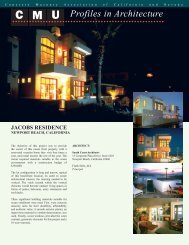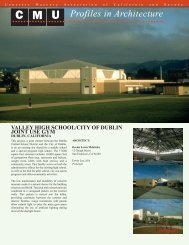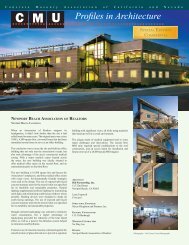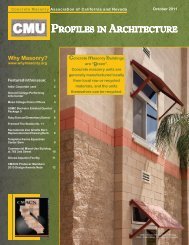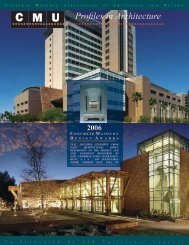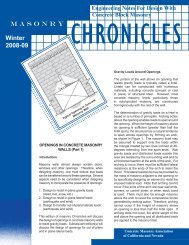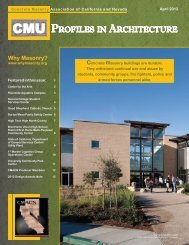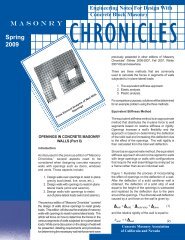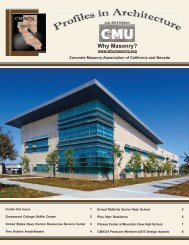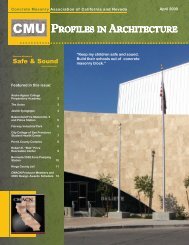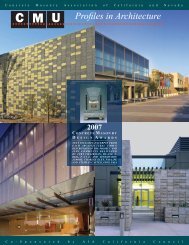Masonry_Chron_Spring.. - Concrete Masonry Association of ...
Masonry_Chron_Spring.. - Concrete Masonry Association of ...
Masonry_Chron_Spring.. - Concrete Masonry Association of ...
You also want an ePaper? Increase the reach of your titles
YUMPU automatically turns print PDFs into web optimized ePapers that Google loves.
Special Inspection<br />
Special Inspection is not required by the 1997 Uniform<br />
Building Code for designs developed using Working Stress<br />
Design. However, when Special Inspection is not used, the<br />
code requires a reduction in the allowable stresses:<br />
"When quality assurance provisions do not<br />
include requirements for special inspection as<br />
prescribed in Section 1701, the allowable<br />
stresses for masonry in Section 2107 shall be<br />
reduced by one half."<br />
…Section 2107.1.2 1997 UBC<br />
Additionally, in the 1997 UBC Special Inspection is<br />
required for designs developed using Strength Design:<br />
"Special inspection during construction shall be<br />
provided as set forth in Section 1701.5, Item 7."<br />
…Section 2108.1.2 1997 UBC<br />
The MSJC Code does not include any mention <strong>of</strong><br />
Special Inspection for either Working Stress or Strength<br />
Design. Note, however, that in Section 1704.5 <strong>of</strong> the<br />
2003 IBC two levels <strong>of</strong> special inspection are specified<br />
depending on the classification <strong>of</strong> the structure and the<br />
level <strong>of</strong> occupancy.<br />
Working Stress Design<br />
Strength Requirements<br />
In the MSJC Code it is permissible to design structures<br />
using the strength design load combinations with<br />
allowable stresses from working stress design multiplied<br />
by adjustment and strength reduction factors.<br />
When strength design load combinations are used, the<br />
design strength <strong>of</strong> a member, its connections to other<br />
members and its cross sections is given as<br />
2.5F a . Where F a is calculated according to the<br />
provisions <strong>of</strong> working stress design, the strength<br />
reduction values, , are as follows:<br />
<br />
Axial load 0.8<br />
Flexural compression 0.8<br />
Flexural tension in unreinforced masonry 0.4<br />
Shear 0.6<br />
Shear and tension on anchor bolts<br />
embedded in masonry 0.6<br />
…Section 2.1.3.3.3 MSJC Code<br />
Note that this section <strong>of</strong> the MSJC Code is not allowed<br />
by the 2003 IBC per Section 2107.1.<br />
Shear Wall Design Loads<br />
In the 1997 UBC, shear stresses for shear walls in<br />
Seismic Zones 3 and 4 must be designed to resist 1.5<br />
times the forces required by the minimum design lateral<br />
forces. The MSJC Code does not use a similar multiplier.<br />
Anchor Bolts<br />
The determination <strong>of</strong> the allowable loads in tension for<br />
plate, headed, and bent bar anchor bolts is the same in<br />
the 1997 UBC and the MSJC Code. However, text has<br />
been included in the MSJC Code to clarify the calculation<br />
<strong>of</strong> projected area in partially grouted masonry:<br />
"That portion <strong>of</strong> the projected area falling in an<br />
open cell or core shall be deducted from the<br />
value <strong>of</strong> A p …"<br />
Concentrated Loads<br />
…Section 2.1.4.2.2.1 MSJC Code<br />
The allowable bearing stress in the 1997 UBC is given by:<br />
"When a member bears on the full area <strong>of</strong> a<br />
masonry element, the allowable bearing stress F br is:<br />
F br = 0.26 f ' m<br />
When a member bears on one third or less <strong>of</strong> a<br />
masonry element, the allowable bearing stress F br is:<br />
F br = 0.38 f ' m<br />
…Section 2107.2.10 1997 UBC<br />
The increase is permitted only when the least dimension<br />
between the edges <strong>of</strong> the loaded and unloaded areas is<br />
one fourth <strong>of</strong> the parallel side dimension <strong>of</strong> the loaded<br />
area. This accounts for confinement <strong>of</strong> the bearing area<br />
by surrounding masonry, which increases the bearing<br />
capacity <strong>of</strong> the wall. Interpolation is allowed between the<br />
two values.<br />
In the MSJC Code, the allowable bearing stress, F br , is<br />
defined as a maximum <strong>of</strong> 0.25 f ' m However, an increase<br />
in capacity similar to that allowed in the 1997 UBC is<br />
allowed by the application <strong>of</strong> the concentrated vertical<br />
axial load over an increased area:<br />
" but not more than 2A 1 , where A 2 is the<br />
supporting surface wider than A 1 on all sides, or A 2<br />
is the area <strong>of</strong> the lower base <strong>of</strong> the largest frustum<br />
<strong>of</strong> a right pyramid or cone having A 1 as upper base<br />
sloping at 45 degrees from the horizontal and<br />
wholly contained within the support."<br />
…Section 2.1.9.2 MSJC Code



